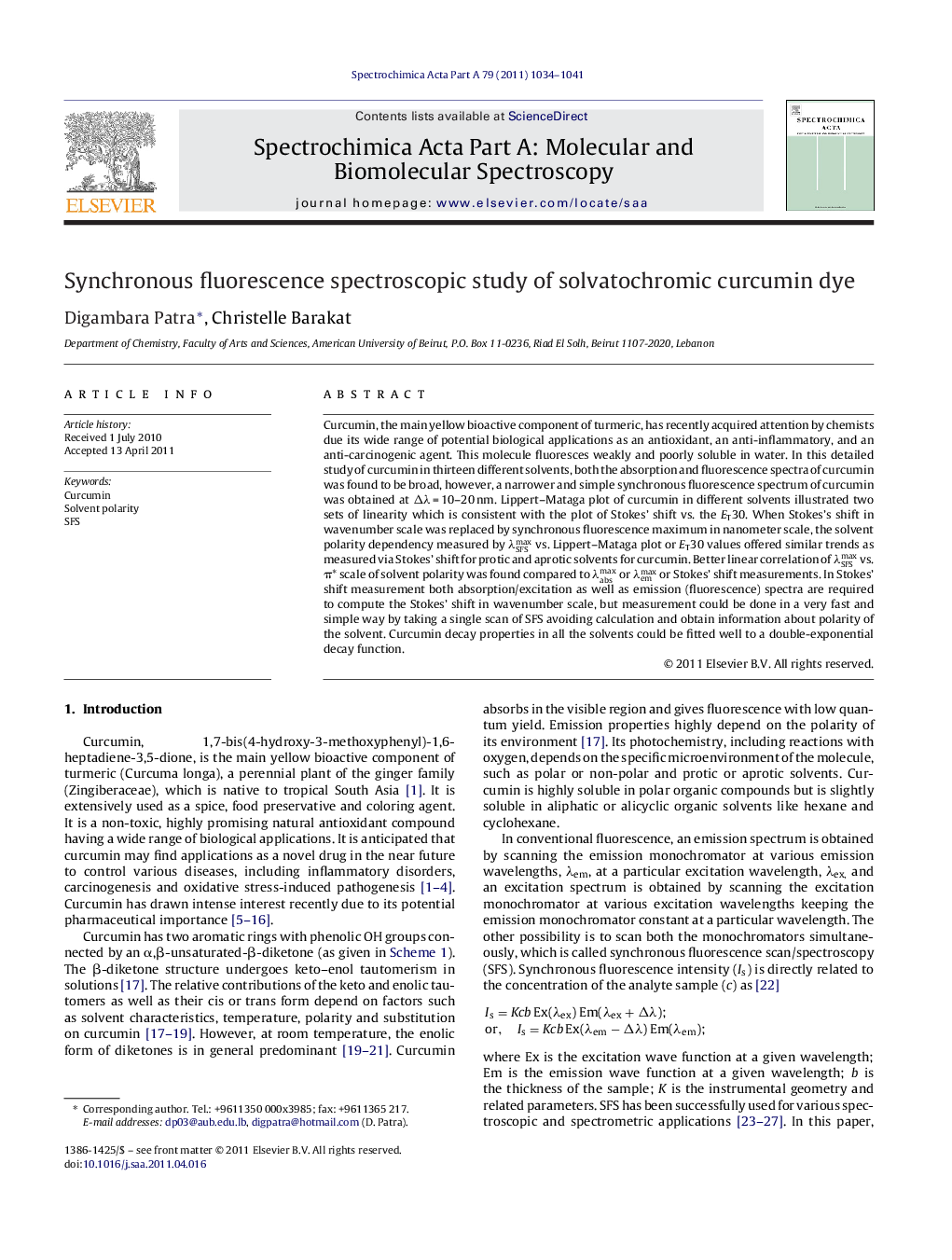| Article ID | Journal | Published Year | Pages | File Type |
|---|---|---|---|---|
| 1236482 | Spectrochimica Acta Part A: Molecular and Biomolecular Spectroscopy | 2011 | 8 Pages |
Curcumin, the main yellow bioactive component of turmeric, has recently acquired attention by chemists due its wide range of potential biological applications as an antioxidant, an anti-inflammatory, and an anti-carcinogenic agent. This molecule fluoresces weakly and poorly soluble in water. In this detailed study of curcumin in thirteen different solvents, both the absorption and fluorescence spectra of curcumin was found to be broad, however, a narrower and simple synchronous fluorescence spectrum of curcumin was obtained at Δλ = 10–20 nm. Lippert–Mataga plot of curcumin in different solvents illustrated two sets of linearity which is consistent with the plot of Stokes’ shift vs. the ET30. When Stokes's shift in wavenumber scale was replaced by synchronous fluorescence maximum in nanometer scale, the solvent polarity dependency measured by λSFSmax vs. Lippert–Mataga plot or ET30 values offered similar trends as measured via Stokes’ shift for protic and aprotic solvents for curcumin. Better linear correlation of λSFSmax vs. π* scale of solvent polarity was found compared to λabsmax or λemmax or Stokes’ shift measurements. In Stokes’ shift measurement both absorption/excitation as well as emission (fluorescence) spectra are required to compute the Stokes’ shift in wavenumber scale, but measurement could be done in a very fast and simple way by taking a single scan of SFS avoiding calculation and obtain information about polarity of the solvent. Curcumin decay properties in all the solvents could be fitted well to a double-exponential decay function.
Graphical abstractStokes's shift in wave number scale replaced by synchronous fluorescence maximum in nanometer scale of curcumin senses polarity of the solvent. Synchronous fluorescence maximum of curcumin vs. Lippert–Mataga plot or ET30 values offers similar trends as measured via Stokes’ shift for protic and aprotic solvents. Better linear correlation is obtained for synchronous fluorescence maximum of curcumin vs. π* scale of solvent polarity. Synchronous fluorescence spectroscopic method is sensitive, simple, easy and fast compare to conventional Stokes’ shift calculation to investigate solvent–solute interaction and general/specific solvent effects.Figure optionsDownload full-size imageDownload as PowerPoint slideHighlights► Stokes's shift in wave number scale replaced by synchronous fluorescence maximum in nanometer scale of curcumin senses polarity of the solvent. ► Synchronous fluorescence maximum of curcumin vs. Lippert–Mataga plot or ET30 values offers similar trends as measured via Stokes’ shift for protic and aprotic solvents. ► Better linear correlation is obtained for synchronous fluorescence maximum of curcumin vs. π* scale of solvent polarity. ► Synchronous fluorescence spectroscopic method is sensitive, simple, easy and fast compare to conventional Stokes’ shift calculation to investigate solvent–solute interaction and general/specific solvent effects.
